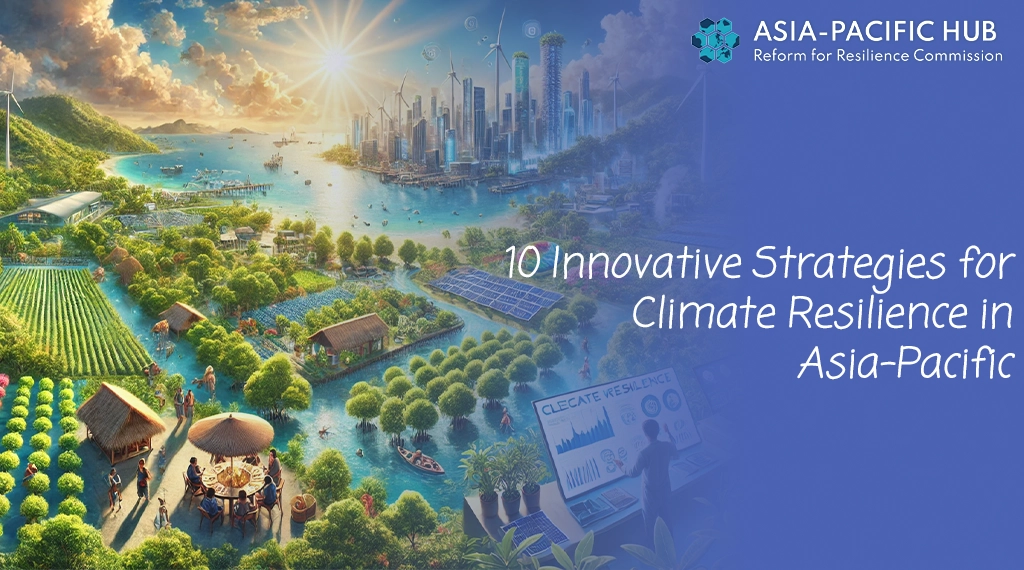
10 Innovative Strategies for Climate Resilience in Asia-Pacific
Resilience APAC – Climate resilience is a growing priority for the Asia-Pacific region as it grapples with rising sea levels, extreme weather events, and shifting ecosystems. At Resilience APAC: Asia-Pacific Hub for Reform, we explore forward-thinking solutions to address these challenges head-on. Here are 10 innovative strategies that can empower communities and ecosystems across the region:
Harnessing the power of nature to combat climate impacts is a sustainable and cost-effective approach. Initiatives like mangrove restoration, coral reef protection, and urban green spaces provide natural buffers against extreme weather while supporting biodiversity.
Transitioning to renewable energy sources such as solar, wind, and geothermal can significantly reduce greenhouse gas emissions. Distributed energy systems, particularly in rural areas, ensure energy access while promoting climate resilience.
Climate-smart agriculture, including drought-resistant crops, efficient irrigation, and agroforestry, helps farmers adapt to unpredictable weather patterns while maintaining food security in vulnerable regions.
Cities in the Asia-Pacific region are at the forefront of climate challenges. Urban planning that incorporates climate-resilient infrastructure, rainwater harvesting, and sustainable transportation systems can mitigate risks for growing populations.
Indigenous communities hold valuable insights into sustainable living and ecosystem management. Integrating traditional practices with modern science enhances resilience while preserving cultural heritage.
READ MORE :New Year’s Eve 2024: Creative Ideas to Make This Year’s Countdown Unforgettable
Investments in early warning systems for floods, cyclones, and heatwaves save lives and reduce economic losses. These systems empower communities to prepare for and respond to disasters more effectively.
Cross-border collaboration on climate initiatives, such as shared water resources management and disaster response frameworks, is vital. Regional partnerships amplify the impact of resilience-building efforts.
Grassroots participation ensures that climate strategies are locally relevant and sustainable. Capacity-building programs, microfinancing, and inclusive policies enable communities to lead adaptation initiatives.
Access to innovative financing mechanisms like green bonds, carbon credits, and climate funds supports large-scale adaptation projects. Public-private partnerships further mobilize resources for resilience investments.
A shift towards circular economies reduces waste and resource consumption. Recycling initiatives, waste-to-energy projects, and sustainable manufacturing practices contribute to resilience and environmental health.
The Asia-Pacific region stands at a critical juncture in addressing climate challenges. By implementing these innovative strategies, we can pave the way for a sustainable and resilient future.
Discover more about regional initiatives and transformative solutions at Resilience APAC: Asia-Pacific Hub for Reform. Together, we can build a climate-resilient Asia-Pacific.
Resilience APAC: Asia-Pacific Hub for Reform - Industrial companies now measure how extreme weather, regulation, and shifting markets shape the…
Resilience APAC: Asia-Pacific Hub for Reform - Governments and companies increasingly rely on climate adaptation partnerships APAC to fund resilient…
Resilience APAC: Asia-Pacific Hub for Reform - Rising losses from extreme weather are forcing companies to prioritize climate adaptation for…
Resilience APAC: Asia-Pacific Hub for Reform reports the growing shift toward value-based care industry impact as healthcare systems move from…
Resilience APAC: Asia-Pacific Hub for Reform reports that africa cape route shipping is no longer a temporary fix but a…
Resilience APAC: Asia-Pacific Hub for Reform menyoroti bagaimana digital twins untuk industri mengubah cara pabrik, energi, dan logistik merancang, mengoperasikan,…